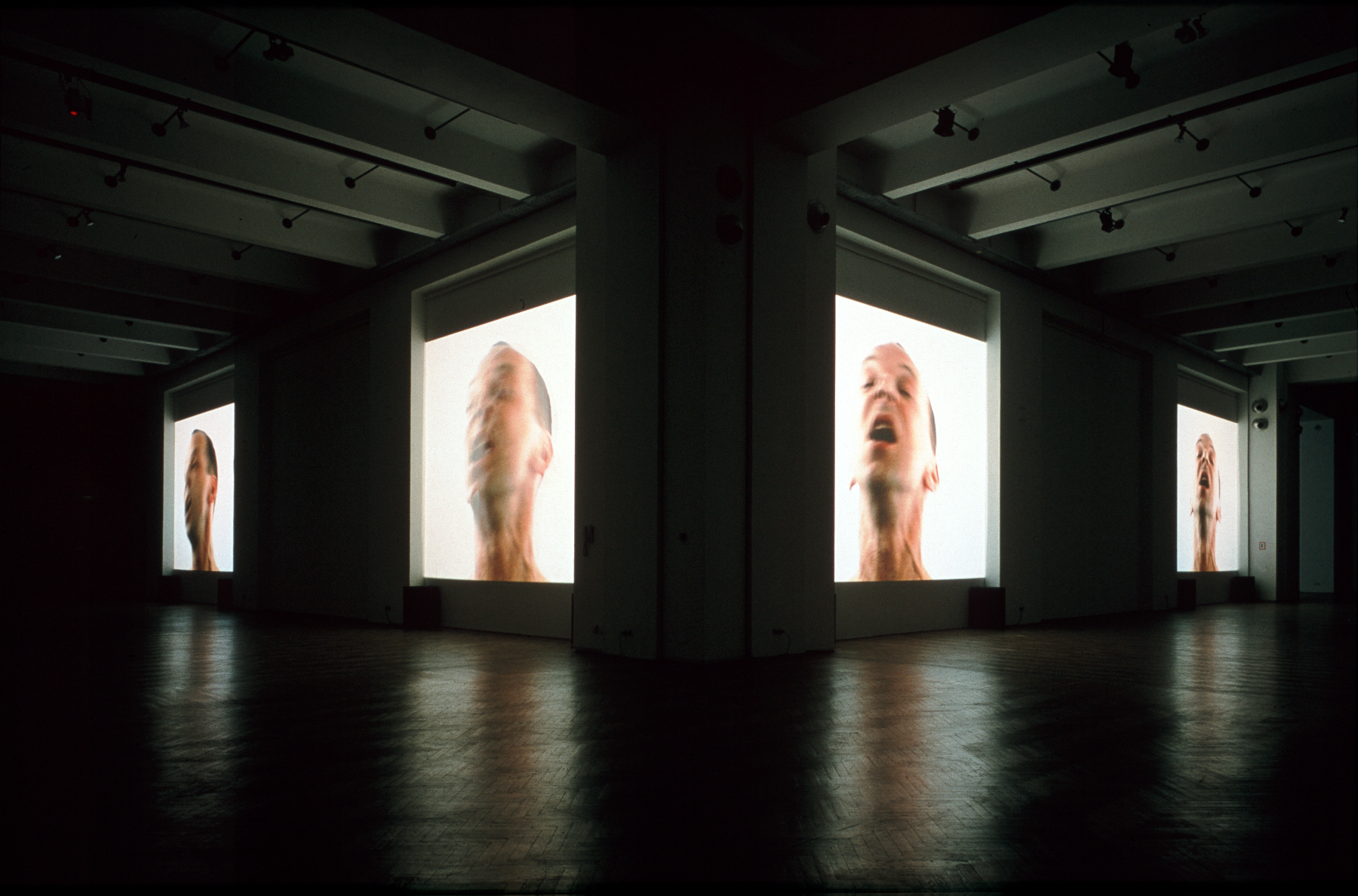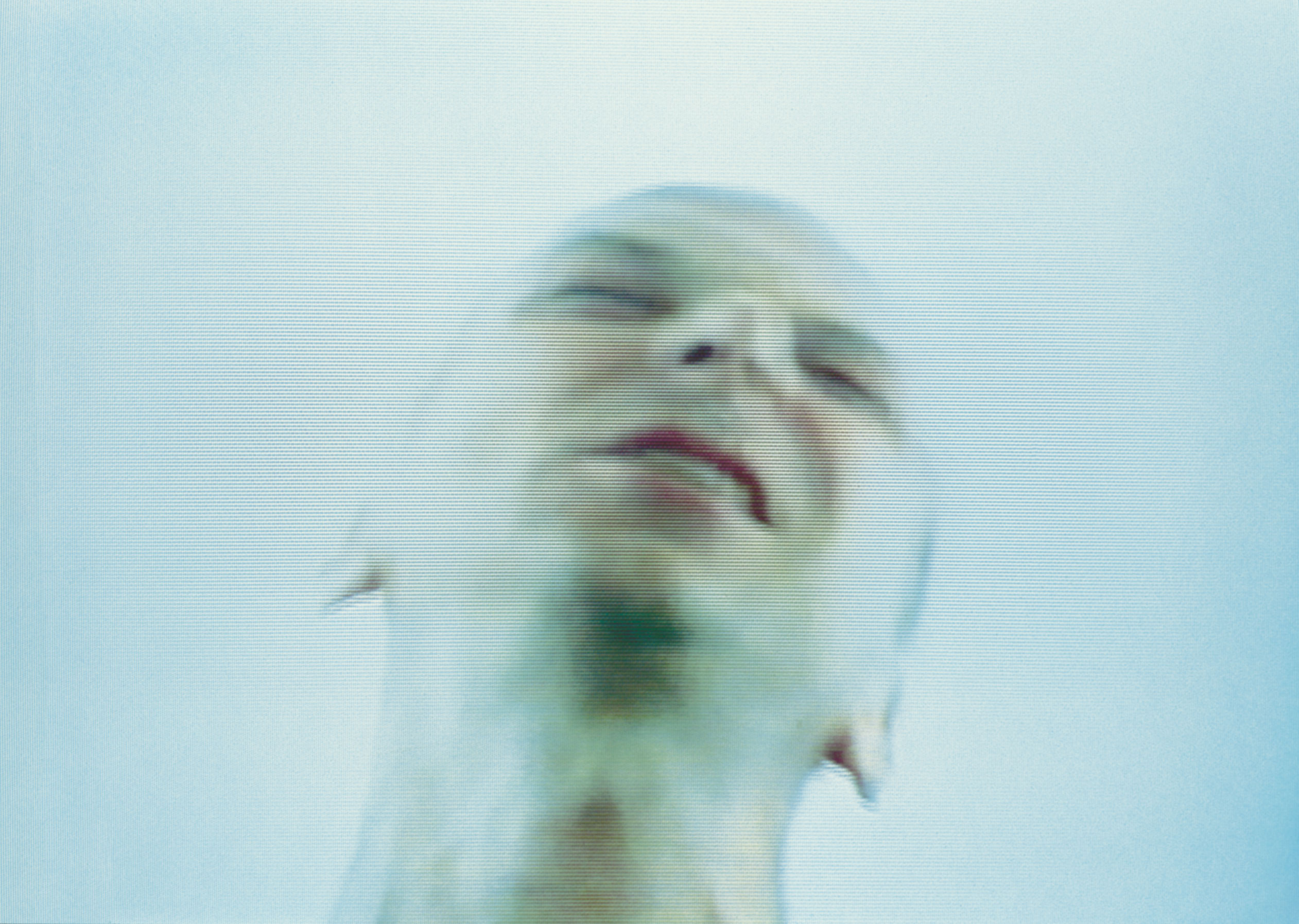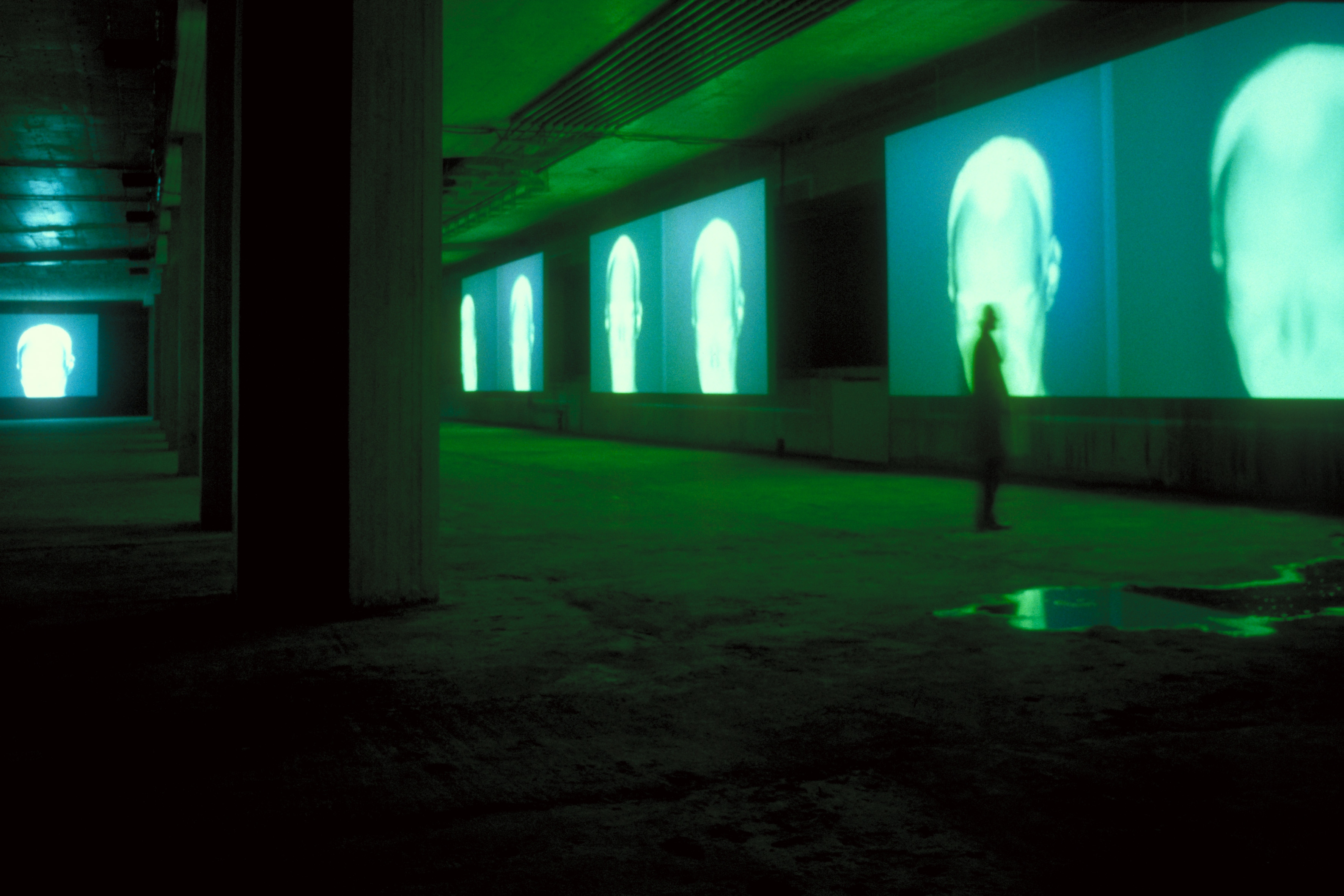NOISEGATE-M6
1998-2000
Realtime, partially Interactive Audiovisual Installation
6-Channel Video, 12-Channel Audio
Featuring Performer Michael Krammer








NOISEGATE
“From the exterior and upon first entering NOISEGATE, the installation had a terrifying air about it. There was something tangibly uncomfortable about walking into a completely dark space towards a brutal noise - the source of which was initially unseen. For a few, fleeting seconds the mind's subconscious took over and dredged up horrific images from mankind's past. Some stood staring at the vast images, others wandered around absorbing the noise and light indirectly. The almost imperceptibly slow movements of the green faces caught newcomers unaware as they occasionally, very suddenly and dramatically flickered into a blue/white negative - like some painful X-ray experience - a disturbing, harsh screeching in the noise stuttering as the images rapidly changed, caused the woman in front of me to physically jump out of shock. But once immersed in the installation the effect was quite different. I experienced something strangely calming, which at the same time stimulated the audio/visual/tactile senses in ways the body isn't used to. “
Rob Dyer
"NOISEGATE" National Museum of Photography, Film & Television, Bradford 28 July - 10 September, 2000
"A tangibly uncomfortable dark space and brutal noise"
GRANULAR SYNTHESIS are Vienna-based duo Kurt Hentschläger and Ulf Langheinrich who specialise in spectacular audiovisual installations. NOISEGATE debuted in 1998 and is currently touring the world. In between the likes of Vienna, Munich and New York it was then slightly surprising to see Bradford listed as the city of choice for the installation's UK debut. But the National Museum of Photography, Film & Television (NMPFT) was the ideal venue and since I was going to be in Bradford for the annual InFest festival I had the perfect opportunity to check out the mysterious NOISEGATE.
The NMPFT in Bradford is a large building over five floors and a basement level. I was strolling around, several floors up from the installation, killing time until it opened at 2.30pm, when suddenly the building began to vibrate to an alarming droning noise. It sounded as though some huge piece of technical machinery had gone wrong in the basement and was close to exploding. I immediately checked my watch - 2.30pm - NOISEGATE had begun.
By the time I'd made my way to the entrance to the installation, people were already hovering around the doorway which was guarded by a member of the Museum's staff. A middle-aged woman emerged from behind the door with a grimace on her face, "It's just noise" she said with a mixture of what seemed like confusion and disgust. The doorman handed out information sheets to the odd mix of people with quizzical looks on their faces hovering around the entrance area - drawn by the curious, loud noise. He and the sheets acted as a filter to the prospective patrons. The standard warnings about strobe lighting, extremely dark environment etc. were accompanied by a few sentences attempting to 'acclimatize' people to the large space they were about to enter. These included notes on the very loud noise levels and vibrating floor. Bearing in mind that at least half of those queuing were families out for 'a nice day' at the museum, the warnings about the unusual nature of the installation concluded with a somehat cautious "we hope you enjoy the experience".
You entered the NOISEGATE space through a pitch black corridor, which quickly opened into an equally dark and bare gallery area (approximately 150 cubic feet). People were gathered toward the rear of the room - some standing with their backs against the wall, others sitting on the floor. In front of them were three walls angled towards the back wall, each wall with two huge video screens next to each other. Green-toned images of a man's face on each of the six screens were the only source of light in the installation. A surround sound system pumped out scraping, droning, white noise and bass tones. I sat down. Very slowly the images moved and flickered - suddenly animated for a few seconds. A man hitting his face against glass, grimacing (recalling the lady who left NOISEGATE as I entered it), the image half negative, half skeletal, switching from sudden flurry of juddering movement to (almost) still visage. Although the audio was extremely loud it was never uncomfortable, never too loud, perhaps a result of the impressive sound system and clever choice of sound waves.
Many people walked in one side of the room only to see what was on offer and immediately walk across the space and out the other side. Very young children walked in with their parents and intuitively sat down - leaving their older family members groping for some point of reference. Some even laid out upon the wooden floor to feel the vibrations of the frequencies pass through their whole bodies - as if feeling it through their feet alone wasn't enough. Copying their innocent exploration, I too laid down. With my palms on the floor, head facing the black void above, I couldn't see the images on the screens but could see the shifting colours of the ambient light they created. I felt like part of the installation, part of the NOISEGATE. Being in a cinema in that brief moment when the house lights go down but before the screen lights up was the only remotely similar experience, but the noise made all the difference.
Some stood staring at the vast images, others wandered around absorbing the noise and light indirectly. Ignorant kids did their best to scream and shout but the frequencies of the noise almost completely drowned out their voices and the relentless drone quickly out lasted any breath they could summon up. The almost imperceptibly slow movements of the green faces caught newcomers unaware as they occasionally, very suddenly and dramatically flickered into a blue/white negative - like some painful X-ray experience - a disturbing, harsh screeching in the noise stuttering as the images rapidly changed, caused the woman in front of me to physically jump out of shock.
From the exterior and upon first entering NOISEGATE, the installation had a terrifying air about it. There was something tangibly uncomfortable about walking into a completely dark space towards a brutal noise - the source of which was initially unseen. For a few, fleeting seconds the mind's subconscious took over and dredged up horrific images from mankind's past. But once immersed in the installation the effect was quite different. I experienced something strangely calming, which at the same time stimulated the audio/visual/tactile senses in ways the body isn't used to. It reminded me very much of some of the installations at the Sonic Boom event at the Hayward Gallery in London earlier this year - although on a much larger scale than anything seen there. It was a truly memorable encounter and one that I'd recommend to anyone adventurous.
Rob Dyer, Dark Stark Magazine
________________________________
Robin Rimbaud crosses the NOISEGATE with GRANULAR SYNTHESIS
excerpts
“…With the quality of a gigantic aquarium each screen project images of the disembodied head of Viennese dancer and performer Michael Krammer, caught as if behind the screen, enclosed and compressed in the darkness. As the image breaks and dissolves a massive sonic field envelopes you in dislocated abstract tones, which move in synchronisation with the granulated images. A sense of pressure in time and space is created by the apparent entrapment of this cloned colossus within the screen each thrust of Krammer’s head into the glass case held within reverberating around the arena. (….) In a sense we are all encased in this contracted space. The experience grows into the suite. We learn more about the movement and structure of the work as we attend to its changing moods; the swelling of the sound and disintegration of the images….”
-Robin Rimbaud WIRE 1998
_____________________________
Das Presse-Online Archiv
Erscheinungsdatum: 20.01.199820. Ressort: Kultur/Medien
Höllentore und maximales Lärmen
"Noise Gate M6" im Museum für angewandte Kunst: Der Dialog Mensch-Maschine bestimmt auch die neueste Video-Installation des Künstlerduos "Granular Synthesis".
VON JOHANNA HOFLEITNEREin gefragter Medienkunst-Exportartikel ist das in Wien ansässige Künstlerduo "GRANULAR Synthesis". Seit sechs Jahren arbeiten der Deutsche Ulf Langheinrich und der Linzer Kurt Hentschläger an ihrem Projekt. Zur Zeit halten sie bei Variante "M6", welche nach der MAK-Schau durch Europa touren wird. Auch diesmal produziert GRANULAR Synthesis ein gen unendlich maximiertes Lärmen, Dröhnen, ein unaufhörliches Rauschen von Bildern, Klängen. Von Beginn an wurden GRANULAR Synthesis von einem Medienfestival zum nächsten gereicht - mit der stets neuesten Variante ihrer nach oben hin offenen Reihe "Modell x.x", an deren Fortschreibung und Maximierung sie wie Software-Engineers arbeiten. Immer steht der je und je neu zu inszenierende, von den Künstlern mittels Synthesizern und Video-Samplern gesteuerte Dialog Mensch-Maschine im Zentrum der Auftritte. So steht auch der Name des Teams für die Methode: "GRANULAR Synthesis" bedeutet in etwa "Zusammenfügung von Körnern" - womit die Grains, die Moleküle der Videobilder und der Töne gemeint sind. Zentraler Bestandteil des ästhetischen Prozesses ist die kontinuierliche Verbesserung der High-Tech-Apparate. Da nimmt es nicht wunder, daß sich die Titel der "Modelle" ausnehmen wie die Bezeichnung der neuesten Variante eines Computer-Programmes. Traten die beiden bisher mit Performances, die einen wild-pulsierenden Theaterabend lang dauerten, in Erscheinung, so feiern sie nun im Wiener MAK mit der Raum-Klang-Installation "Noise Gate M6" Premiere im Sinne einer musealen Ausstellung. Schon im Foyer dröhnen dumpfe Bässe, das Gebäude scheint zu vibrieren. Zutritt zur Ausstellungshalle erlangt man durch eine kalte Schleuse, die einer Fahrstuhlkabine ähnelt - Klaustrophobie ist programmiert. Hat man die Pforte passiert, ist man von Finsternis umgeben - ein bedrohlicher Bauch des technologischen Zeitalters, einzig ausgefüllt von der hämmernden Masse elektronischer Klangfasern. Rundum in den sechs Wandfeldern des lichteren, durch eine weitere Schleuse erreichbaren Umgangs: ein Video-Cordon mit riesenhaft vergrößerten Männerköpfen. Durch digitale Bearbeitung sowie Sensoren, die die Bewegung des Publikums aufnehmen, zerbröseln die Bilder, um sich aus der Vibration heraus dann neu zu organisieren. Mit "Noise Gate M6" zeichnen GRANULAR Synthesis ein brutales Porträt des Posthumanismus, rechtzeitig zum Fin de millennium. Hier wird der Besucher an die Grenzen des Erträglichen geführt, erlebt 20 Minuten lang ein Wechselbad der Gefühle. Einzig, doch entscheidend, bricht sich diese Gratwanderung in der Ironie des ästhetischen Spieles. Sich für diese coole Installation zu erwärmen, ist unmöglich. Genau dieses Paradoxon ist der springende Punkt.
_____________________________________
Le Devoir, Montreal, Quebec
April 17, 1999
Between Spell and Irritation
NOISEGATEGRANULAR SYNTHESIS
Musée d’art contemporain de Montréal,
185 rue Sainte-Catherine Ouest
Open until May 16
Bernard Lamarche
At present, the Montreal Museum of Contemporary Art (MACM) is housing a major work, major in terms of its monumental scale, and of the underlying high-tech. It is an overwhelming video work by the Austria duo Granular Synthesis (GS) who have been widely acclaimed by critics wherever they showed their works and who are by no means making their début in the development of monumental installations of this kind. In the framework of the 1995 ISEA in Montreal GS presented MODELL 5, repeated images of the face of a young women in convulsions set to haunting music amplified to the point of the unbearable.
Formed in 1991, the duo consisting of Kurt Hentschläger and Ulf Langheinrich specializes in sound and visual environments in which the feelings of alienation and confinement are stimulated by the bodies of the spectators and the models who are part of the imagery being absorbed by the machinery so that a virtual version of a complex cyborg evolves, hysterical, caught up between and shaken by rule-bound programming and drifting emotions.
Synthetic Granulation
In their productions, the team uses a technique of audio signal sampling, synthetic granulation, from which they also derived their name. The signal is split up and the grain thus isolated can be reduced and re-arranged in new sequences in a process of sampling or cloning. Not only does the new technique make it possible to explore micro-tonal variations of timbres digitized this way, it also allows for an alignment of these sounds along a time matrix fundamentally alien to them. Thus certain effects of familiarity are undermined by the non-linear re-organization of sounds and images. This is what the visitor can experience in the basement of the MACM. The materiality of the amplified sound causes unique sensations: the rib cage vibrates to the beats of the noise music while complex ways of toying with the stereo sound make you believe in auditive hallucinations because the sounds you hear are split into several signals.
The deafening installation uses a highly sophisticated technique called granular synthesis. Visitors enter a hall in total darkness, and following a pathway marked by lights, they are led into the heart of the machinery and walled in by very loud industrial noise. In the hall, visitors are surrounded by a huge enclosure of six giant screens enveloping them with brutal force. These screens show sequences of film, a kind of vibrating variation on the same visual theme, the order of which follows an unpredictable logic. A head, alternatingly shown in positive and negative projection, falls prey to irritating convulsions seemingly due to a disturbance in the program. The stern face is seized by trembling fits, passing through various stages of suffering and catatonia while the pervasive noise becomes twice as strong through the thuds.
_______

